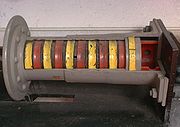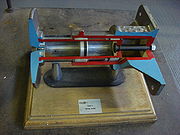
Buffer (rail transport)
Encyclopedia


Europe
Europe is, by convention, one of the world's seven continents. Comprising the westernmost peninsula of Eurasia, Europe is generally 'divided' from Asia to its east by the watershed divides of the Ural and Caucasus Mountains, the Ural River, the Caspian and Black Seas, and the waterways connecting...
, for attaching railway vehicles to one another.
Fitted at the ends of the vehicle frames, one at each corner, the buffers are projecting, shock-absorbing pads which, when vehicles are coupled, are brought into contact with those on the next vehicle. The draw chain used between each pair of vehicles includes a screw which is tightened after coupling to shorten the chain and keep the buffers pressed together. Such is known as a 'screw coupling'. Historically, coupling chains were no more than that, a short length of heavy chain (typically three links long) with no adjustment. These would result in a 'loose-coupled train' in which the buffers of adjacent vehicles would only touch when the coupling chain was fully slack, such as when being pushed or going down hill.
Although the buffers in the very earliest days of railways were rigid (dumb buffers), they soon came to be spring-loaded, while those fitted to modern locomotive
Locomotive
A locomotive is a railway vehicle that provides the motive power for a train. The word originates from the Latin loco – "from a place", ablative of locus, "place" + Medieval Latin motivus, "causing motion", and is a shortened form of the term locomotive engine, first used in the early 19th...
s and rolling stock
Rolling stock
Rolling stock comprises all the vehicles that move on a railway. It usually includes both powered and unpowered vehicles, for example locomotives, railroad cars, coaches and wagons...
incorporate oleo-pneumatic shock absorber
Shock absorber
A shock absorber is a mechanical device designed to smooth out or damp shock impulse, and dissipate kinetic energy. It is a type of dashpot.-Nomenclature:...
s.
Dead-end sidings are often fitted with buffer stops to prevent vehicles running off the end of the track. These may consist of a simple transverse beam fixed at buffer height but the buffer stops at passenger stations can be elaborate hydraulic installations capable of absorbing a considerable amount of energy.

